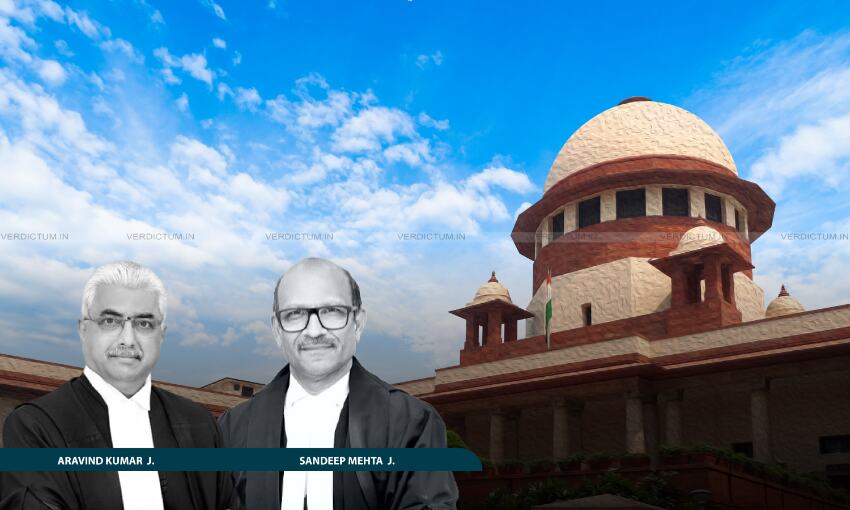Supreme Court Upholds Conviction Of Man Accused Of Wife’s Murder Relying On Daughter’s Evidence

The Supreme Court has affirmed the conviction of a man accused of murdering his wife, relying on the statement of the child, observing that he failed to provide a credible explanation under Section 106 of the Evidence Act as to under what circumstances the deceased sustained the fatal injuries, particularly when the incident took place within the four walls of the house.
The Court was considering an Appeal against the High Court’s ruling whereby the Trial Court’s order wherein the Accused-Appellant was convicted and sentenced to rigorous imprisonment for life and fine of ₹5,000/- and in default of payment of fine to suffer further rigorous imprisonment for one year was confirmed.
The Bench of Justice Aravind Kumar and Justice Sandeep Mehta observed, “…..the High Court affirmed the finding of guilt of the accused-appellant as recorded by the trial Court by a well-reasoned judgment dated 1st April, 2011. It is our firm opinion that the conviction of the accused-appellant as recorded by the trial Court vide judgment dated 14th August, 2007, and affirmed by the High Court vide judgment dated 1st April, 2011, does not suffer from any infirmity.”
The Appellant was represented by Advocate-on-Record Md. Farman while the Respondent was represented by Advocate Anurag Gharote.
Facts of the Case
The Appellant was tried by the Additional Sessions Judge for the offence punishable under Section 302 of the Indian Penal Code, 1860, with the allegation that he committed the murder of his own wife. The Trial Court convicted and sentenced him which was later confirmed by the High Court
The fact regarding the death of the deceased being homicidal, was not disputed by the Counsel for the Appellant. The autopsy report also established beyond all manner of doubt that the death was homicidal in nature having been caused by blunt weapon injuries inflicted on her vital body part, i.e., head.
The case of the Prosecution was based on the evidence of Appellant’s own daughter who was present in the house at the time of the incident. The child witness gave convincing evidence stating that her father used to pull a cycle rickshaw and her mother used to perform the household duties and also worked as a maid servant. Her father often beat her mother after consuming liquor. On the date of the incident, she was sleeping besides her mother. She was roused from sleep upon hearing some commotion and noticed that her mother was coughing. Her father was sitting nearby her mother who had been covered up by a chaddar (bedsheet). When the child witness enquired from her father, he told that her mother was not feeling well and that he would bring a Doctor. He forbade her from removing the chaddar and taking a look at her mother.
Thereafter, the Appellant went away from the house not to return. The child witness removed the chaddar and noticed that bleeding injuries on the head of her mother who was immobile. Upon noticing these bleeding injuries, she panicked and called their landlord and his wife, who came to their house. In cross-examination, the child witness stated that her father was sick and did not do any work and used to be at the house. Her brother used to help her mother by selling ice-candy and sometimes he used to come home late. For this reason, her mother and father used to quarrel with each other. A pertinent answer was given by the child witness in cross examination that she along with her father and mother were sleeping in the house after taking meals.
Reasoning By Court
Taking note of the fact that the Child Witness denied the theory of false implication set up by the defence and stood firm on the aspect that the Appellant was sitting nearby her mother, the Court observed, “It is thus clear that the accused-appellant was the only able bodied person present in the house apart from the child witness when Smt. Ranjana was beaten to death while she was sleeping besides the child witness.”
It thus ruled that the blank denial offered by the Appellant in his statement under Section 313 of Code of Criminal Procedure, 19734 is rendered futile upon perusal of the cross-examination of the child witness wherein, the presence of the Appellant in the house at the time of the incident has been reinforced by way of answers solicited from the child in response to suggestions given to her in cross-examination.
“Suffice it to say, that the child witness had no reason whatsoever to give false evidence implicating her own father for the murder of her mother. The bald plea of denial advanced by the accused-appellant in his statement under Section 313 CrPC, is clearly an after-thought and insufficient to discharge the burden cast upon him by Section 106 of the Evidence Act, 1875”, the Court observed.
Finding her testimony to be absolutely natural, the Court concluded that the Child Witness is a witness of sterling worth.
“The lame suggestions given by the defence to the child witness that she might have been tutored by her grandmother and maternal uncle to give evidence against the accused-appellant do not carry any weight whatsoever. Her evidence is duly corroborated by the testimony of the landlord, Shri Arun Bhagwantrao Khandetod (PW-1) and the Medical Jurist (PW-4)”, the Court observed.
Noting that at the time of his arrest, the shirt worn by the Appellant was found to be stained with blood of “group A” i.e., blood group of deceased, thereby connecting the Appellant to the incident
“It is thus discernible that the accused-appellant and none else was responsible for causing the fatal injuries to his wife Smt. Ranjana”, the Court ruled.
The Appeal was accordingly dismissed.
Cause Title: Manohar Keshavrao khandate vs. State of maharashtra
Appearances:
Appellant-Advocate-on-Record md. Farman, Advocate Adity`tanwar, Advocate Salman Khan
Respondent-Advocate Anurag Gharote, Advocate Siddhartha Dharmadhikari, Advocate-on-Record Aaditya Aniruddha Pandey

